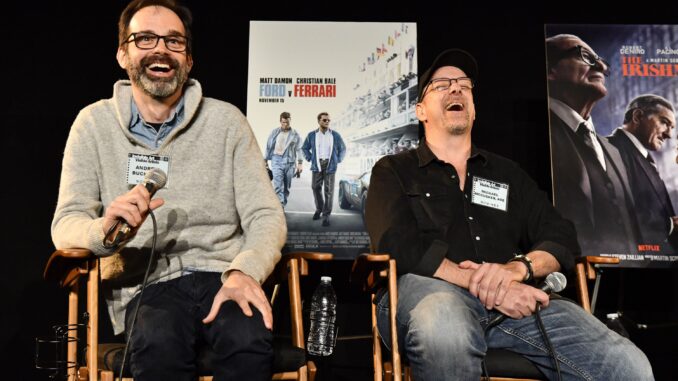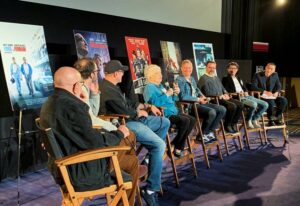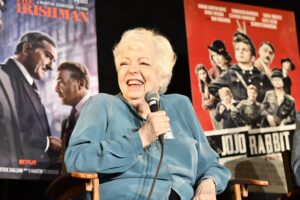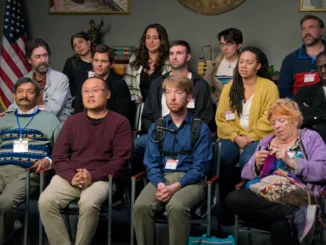
by Mel Lambert
On Saturday — the day before the 92nd Academy Awards — a capacity audience gathered at The Egyptian Theatre in Hollywood to celebrate the art of picture editing.
All of the Oscar-nominated editors appeared at a panel discussion during the American Cinema Editors’ 20th Annual “Invisible Art, Visible Artists” (IAVA) to talk about their films, their careers, and their craft. That included Guild members Michael McCusker, ACE, and Andrew Buckland, who would eventually pick up the Oscar for “Ford v Ferrari,” along with Tom Eagles (“Jojo Rabbit”), Jeff Groth (“Joker”), and Thelma Schoonmaker, ACE (“The Irishman”). Rounding out the panel was Yang Jinmo, the picture editor of the South Korean dark comedy “Parasite,” which would win Best Picture.
Panel moderator (and Guild President) Alan Heim, ACE, kicked off the proceedings by asking the panel whether contemporary films are too long, with “Ford v Ferrari” running 2:32 and “The Irishman” at 3:29. Heim mischievously suggested that picture editors are in a unique position to reduce extended running times.
‘That Takes Time’
“Marty [Scorsese, producer/director] never intended ‘The Irishman’ to run that long,” stated Thelma Schoonmaker ACE, who edited the film about a conflicted Mob hitman (Robert De Niro) who befriends labor leader Jimmy Hoffa (Al Pacino). “He thought it only ran an hour and a half, but wanted the pace to build slowly, which takes time.”
“The front-end of ‘Ford v Ferrari’ had to be long because we had so much pipe to lay to tell the film’s back story,” said McCusker who, with Buckland, co-edited the high-speed racing saga. “In fact, people kept asking: ‘How much time can we spend before the audience becomes restless?’ But they will stay with you if you have emotional content.”
Buckland agreed: “Those later race sequences are more important because we have identified all the characters. That takes time.”

Eagles, who edited “Jojo Rabbit,” said that he trimmed the film from its original cut, but only for story clarity.
“World-building was important for this film,” about a young boy in Hitler’s army who discovers that his mother is hiding a Jewish girl, Elsa. “We needed to get to the Elsa sequence quickly to retain audience attention,” Eagles said. “We adopted a breathless rhythm to underscore the teenager’s ADD, which resulted in a fast-moving first act.”
“Todd Phillips, who directed ‘Joker,’ predicted at the start of editing that the film would run 1:53,” recalled Groth. “We ended up at 2:20 – which seemed to be the target for comic-book films – but gradually trimmed it to 1:54 before credits. But not by speeding up the film, since we wanted to keep the pace slow as the film’s lead character, Arthur Fleck [played by Joaquin Phoenix], makes the transition to Joker.”
“Director Bong can make his films as long as he needs them to be,” said “Parasite’s” Jinmo, speaking occasionally through his Korean translator. “But we cannot bore the audience, which might choose to walk out! My focus is always to find the best pacing and the best performances for each scene. An editor needs to introduce characters,” including members of the film’s unemployed family that show a bizarre interest in their wealthy neighbors. “When the film’s pacing works you end up with a successful length,” Yang concluded.
The remainder of the morning’s presentation comprised illustrative clips from the five nominated films by their respective editors, starting with “Ford v Ferrari,” for which Buckland and McCusker had selected an early section when the English race driver Ken Miles (Christian Slater) demonstrates his driving prowess to car builder Carroll Shelby (Matt Damon).

“That’s an example of a scene being found in the edit room,” Buckland said. “We had a lot of second-unit footage from Willow Springs, but it came across as a one-lap race.”
“That was a big problem,” agreed McCusker. “Although the director [James Mangold] thought that the section worked okay, we knew from working with him on so many films that later he would see it through different eyes.”
“Basically, we reconstructed the scene to show the passage of time, add length and make a race of it,” McCusker said. “Andrew [Buckland] voiced some ADR lines as a track announcer counting down the laps, which helped scene-set the sequence for an audience. We brainstormed our way through that highly collaborative process.”
Schoonmaker had selected a slow-paced scene from “The Irishman,” in which mob boss Russell Bufalino (Joe Pesci) is slowly breaking the news to his hitman (Robert De Niro) that he needs to fly to Detroit to kill somebody. “It is a deceptively simple, stripped-down scene, as we focus on the opaqueness of the roundabout way in which the Mafia speaks,” the editor said. “And the actors’ performances in that scene, which was shot early, are stratospheric.”
Asked by Heim why the film did not show close ups of the various killings, Schoonmaker replied that the director “wanted the violence behind the killings to look bland. Any killings are shown in wide shot, with no lingering; they are just doing their job. Marty [Scorsese] likes slow and quiet dialog. Mob bosses do not need to shout; they move quietly.”
‘She Is Not a Monster’
The scene from “Jojo Rabbit” chosen by Eagles focused on the eponymous teenager – a member of the Hitler Youth – as he returns home and discovers an unexpected house guest. “We cut it to look like a minor horror movie; the Jewish girl is the scariest thing that Jojo could find in the house,” he explained. “But she is not a monster. I also cut the sequence against [a temp track] of a Bernard Hermann film score and music from ‘Altered States’,” to inform the pacing of his edit.
Heim asked if the complex role played by the iconic Adolph Hitler character caused any concerns during the edit. “Our only pick-up [by director Taika Waititi] was an opening scene with Hitler, because we needed the audience to either exit or stay once they understood the film’s premise. After all, the kid is not a fanatical member of Hitler Youth. There is a hanging in the town square after a comedic sequence; the audience now knows first-hand where the film is going.”
Groth’s selected clip from “Joker” showed the mentally disturbed title character being attacked on the Gotham City subway as he starts his downward spiral of revolution and crime to come face-to-face with his alter-ego.

“That character transformation” – as the physical assault turns into a revenge killing – “shows [Fleck] searching for an identity while he wants the passengers to see his interaction with and reaction to the growing danger,” which manifests itself as maniacal laughter. “That scene marks a change of character,” Groth said.
“And we see [Joker’s] confusion; after the shooting he is still not sure how to proceed,” the editor added. “The Hunted becomes the Hunter. During the last shot of that scene, it’s almost as if Joker is thinking: ‘Ah, that was interesting; I never expected to feel that way.’ Audiences seem to recognize that transformation at different times in the film.”
Asked by Heim about the use of cuts in the black during the assault scene, as the subway train’s lights flickered on and off because of track changes. “That technique added tension, and contributed to the fever dream aspect of the sequence,” Groth said.
Yang’s selected clip from “Parasite,” showed the frantic reaction of the people squatting in the house’s basement to the news that the wife and children of the wealthy owners would soon be returning home. “That scene has everything,” the editor said. “Good dialog, good acting, and good production design. It was fun to edit, despite the technically challenging shots. We sped up the camera movements to get the right rhythm and the right timing.”

Revealing that he made his first cut against a temp music track of the Winter Concerto from Antonio Vivaldi’s “Four Seasons,” “I then wanted to speed up the track by 10-13%, which is the version audiences see on the screen,” Yang said. Eventually, the temp music was replaced with a score composed for the film by Jaeil Jung.
‘They Find Out How You Work’
During a Q&A segment at the event’s conclusion, one audience members asked perhaps the inevitable question: “How do you develop relationships with film directors?”
Groth said that such relationships develop over time. “It’s a process of them seeing what you do. The first film is rather like an internship as they find out how you work.”
Schoonmaker’s response was more pragmatic. “First, show the director the way he thought it out,” she advised. “And then refine the cut. If the director disagrees, show both versions of the film. But always remember that that he has been living with the film for a long time; longer than you! There must be absolute trust with no ego.”
Citing playwright David Mamet’s line repeated by the salesmen in “Glengarry Glen Ross” (“ABC: Always Be Closing”), McCusker amended the line to “Always Be Locking: always put your full effort into the film,” he said.
Gold Sponsors for this year’s IAVA event were Adobe, Avid, the Motion Picture Editors Guild and the NAB Show; CineMontage served as a Media Sponsor.






